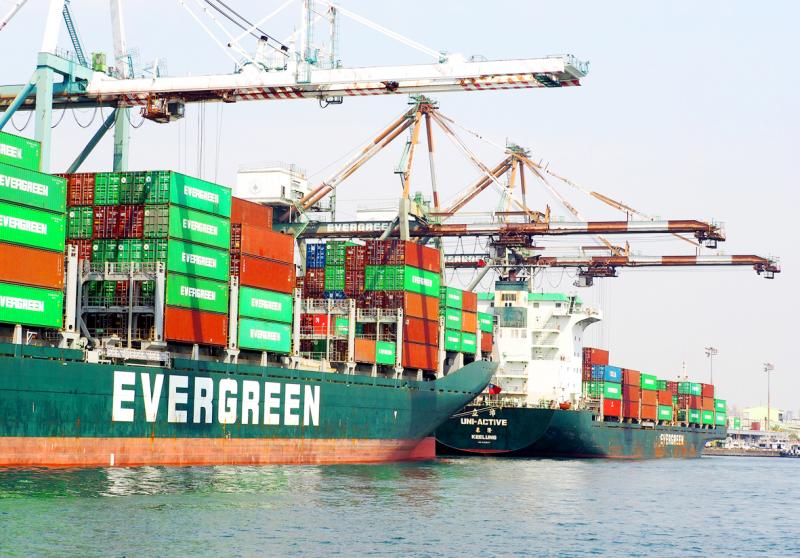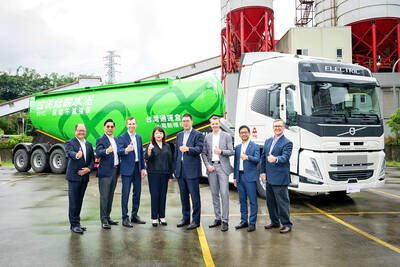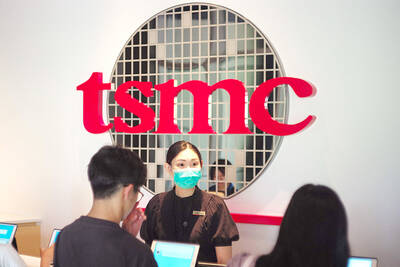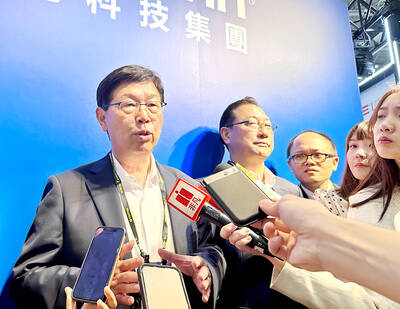Taiwan’s exports last month declined by a marginal 0.6 percent from a year earlier to US$28.27 billion — still the third-highest level for March — as non-tech firms took a hit from an oil price slump, but electronics vendors benefited from inventory replenishment demand from China, the Ministry of Finance said yesterday.
The result was better than a 2 to 5 percent retreat the ministry projected last month, thanks to the smooth resumption of work in China, order transfers and employees working from home, the ministry said.
“It is not clear if the pickup in electronics sales will continue, as the COVID-19 pandemic is halting economic activity in Europe and the US, but demand for 5G deployment and artificial intelligence [AI] applications continues to gain momentum,” Department of Statistics Director-General Beatrice Tsai (蔡美娜) told a media briefing in Taipei.

Photo: David Chang, EPA-EFE
Such factors might leave exports with 0.5 percent growth or a 2.5 percent contraction this month, Tsai added.
The pandemic and the tumbling price of oil weighed on shipments in almost all product categories by double-digit percentages, the ministry said in its monthly report.
Exports of plastic, chemical, base metal, machinery and electrical products reported declines of between 11.5 percent and 20 percent from a year earlier, the report showed.
Customers were hesitant to build up inventory as concerns over a global recession loom larger, the report said.
Shipments to the US dropped 3.1 percent, fell 2.1 percent to Japan and plunged 8.1 percent to Europe, where COVID-19 infections have been rising and authorities have shut down almost all nonessential businesses to combat the disease, it said.
Exports to emerging markets were resilient, increasing 3.4 percent to China and Southeast Asia, the ministry said, citing strong demand for information and communications technology products.
Exports of electronics rose 18.1 percent year-on-year to a record high of US$10.8 billion, with semiconductors mounting a 20.5 percent gain, the report showed.
“Demand for 5G deployment, high-performance chips and AI applications appear unharmed thus far,” Tsai said.
Electronics suppliers also benefited from teleconferencing, distance education and work-from-home technologies, Tsai said.
Imports squeezed a fractional 0.5 percent increase to US$25.48 billion, allowing Taiwan to retain a trade surplus of US$2.78 billion, the ministry said.
While imports of capital equipment dropped 12.7 percent to US$4.4 billion, Tsai said that the value was decent, based on historical comparisons.
For the first three months of this year, exports expanded 3.7 percent to US$78.7 billion, while imports increased 3.5 percent to US$69.17 billion.
Both results beat a forecast by the Directorate-General of Budget, Accounting and Statistics in February.
Looking ahead, the pandemic poses the biggest challenge that could curtail demand for the nation’s exports, Tsai said, adding that global research institutes expect an abrupt recession in the West and a deeper slowdown in China.
Major tech firms might shed more light on the landscape at their upcoming investors’ conferences, Tsai added.

Taiwan Transport and Storage Corp (TTS, 台灣通運倉儲) yesterday unveiled its first electric tractor unit — manufactured by Volvo Trucks — in a ceremony in Taipei, and said the unit would soon be used to transport cement produced by Taiwan Cement Corp (TCC, 台灣水泥). Both TTS and TCC belong to TCC International Holdings Ltd (台泥國際集團). With the electric tractor unit, the Taipei-based cement firm would become the first in Taiwan to use electric vehicles to transport construction materials. TTS chairman Koo Kung-yi (辜公怡), Volvo Trucks vice president of sales and marketing Johan Selven, TCC president Roman Cheng (程耀輝) and Taikoo Motors Group

Among the rows of vibrators, rubber torsos and leather harnesses at a Chinese sex toys exhibition in Shanghai this weekend, the beginnings of an artificial intelligence (AI)-driven shift in the industry quietly pulsed. China manufactures about 70 percent of the world’s sex toys, most of it the “hardware” on display at the fair — whether that be technicolor tentacled dildos or hyper-realistic personalized silicone dolls. Yet smart toys have been rising in popularity for some time. Many major European and US brands already offer tech-enhanced products that can enable long-distance love, monitor well-being and even bring people one step closer to

RECORD-BREAKING: TSMC’s net profit last quarter beat market expectations by expanding 8.9% and it was the best first-quarter profit in the chipmaker’s history Taiwan Semiconductor Manufacturing Co (TSMC, 台積電), which counts Nvidia Corp as a key customer, yesterday said that artificial intelligence (AI) server chip revenue is set to more than double this year from last year amid rising demand. The chipmaker expects the growth momentum to continue in the next five years with an annual compound growth rate of 50 percent, TSMC chief executive officer C.C. Wei (魏哲家) told investors yesterday. By 2028, AI chips’ contribution to revenue would climb to about 20 percent from a percentage in the low teens, Wei said. “Almost all the AI innovators are working with TSMC to address the

FUTURE PLANS: Although the electric vehicle market is getting more competitive, Hon Hai would stick to its goal of seizing a 5 percent share globally, Young Liu said Hon Hai Precision Industry Co (鴻海精密), a major iPhone assembler and supplier of artificial intelligence (AI) servers powered by Nvidia Corp’s chips, yesterday said it has introduced a rotating chief executive structure as part of the company’s efforts to cultivate future leaders and to enhance corporate governance. The 50-year-old contract electronics maker reported sizable revenue of NT$6.16 trillion (US$189.67 billion) last year. Hon Hai, also known as Foxconn Technology Group (富士康科技集團), has been under the control of one man almost since its inception. A rotating CEO system is a rarity among Taiwanese businesses. Hon Hai has given leaders of the company’s six